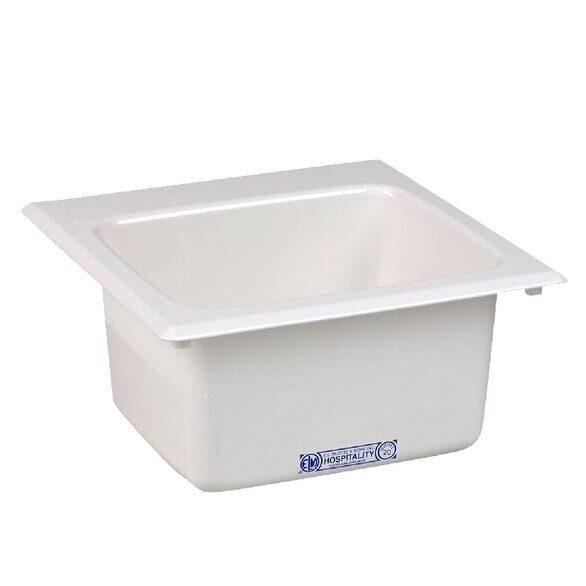Drop-in and Undermount Laundry Sinks for Countertops
Have you decided to have a countertop with drop-in or undermount sink in your laundry room?
In this article, you’ll find all the information you need to choose the sink for your countertop.
If you haven’t yet determined your countertop dimensions, check our article on laundry countertops. And in case you’re still not sure if a countertop is the best option for your laundry room, check our article on freestanding and wall-mounted utility sinks.
Page Contents:
Which is better: a drop-in or a undermount laundry sink?
Drop-in laundry sinks
Drop-in sinks have a visible lip that rests on the countertop.

Pros:
- Easier to clean the sink, as the countertop doesn’t cover any part of it.
- As the countertop cutout is not visible, it doesn’t need to be 100% perfect. A good choice if you’re doing it yourself.
Cons:
- Harder to clean and dry the countertop, as there is an obstacle on the way before the water reaches the sink.
- Slightly smaller counter space.
Undermount laundry sinks
Undermount sinks are glued under the counterop, and the cutout is apparent.

Pros:
- Easier to clean and dry the countertop, as there is no obstacle on the way and the water slides down straight into the sink.
- Slightly larger counter space.
Cons:
- Harder to clean the sink, as the countertop covers a part of it.
- The countertop cutout has to be perfectly finished.
Undermount sinks can also be used if you want a lid, so you can make the most of you countertop space.

Can you change a drop-in sink to undermount?
There are some models that can be used for either installation method and others for one of them only.
If you have a laundry sink made to be drop-in and you want to attach it under the counter, you may have problems due to the sink’s weight. As drop-in models are made to rest on the counter, they may be too heavy to be glued under it.
Also be aware that the sink’s bottom will be a little lower that it was designed to be.
If you want to try, here‘s a guide to do it yourself.
Drop-in and undermount laundry sink materials
Polypropylene, fiberglass, acrylic or plastic

Pros:
- The cheapest option.
- Durable.
- Resistant to scratches and stains.
Cons:
- Not as heat resistant as the other materials.
- Louder when water hits the sink.
Stainless steel

Pros:
- Industrial look can compose an interesting decor.
- Practical and easy to clean.
- Heat resistant.
Cons:
- More expensive.
- Also lightweight and loud. The thicker the material, though, the least noise it makes.
Cast iron

- The most traditional option, cast iron sinks are coated in enamel for a heavy-duty product.
- Durable.
- Heat resistant.
Cons:
- The most expensive type.
- To avoid the exposed iron to rust, you should re-glaze enamel every time it chips.
How to determine the size of a drop-in or undermount laundry sink
After deciding your utility sink installation type and material, you will also find options of size.
Check the dimensions of the options you’re comparing. Choose a larger one if your family and laundry room are large, or a small one if you live alone or as a couple, or have a small laundry room.
That’s it! I hope this guide has made buying a freestanding or wall-mounted laundry sink easy.
After you pick the sink, check its specifications to find out which other items come with the product, such as the faucet and the drain. Some products include these items and some don’t, so make sure to buy everything you will need.
Check out our articles on laundry faucets if you need help to choose one.
